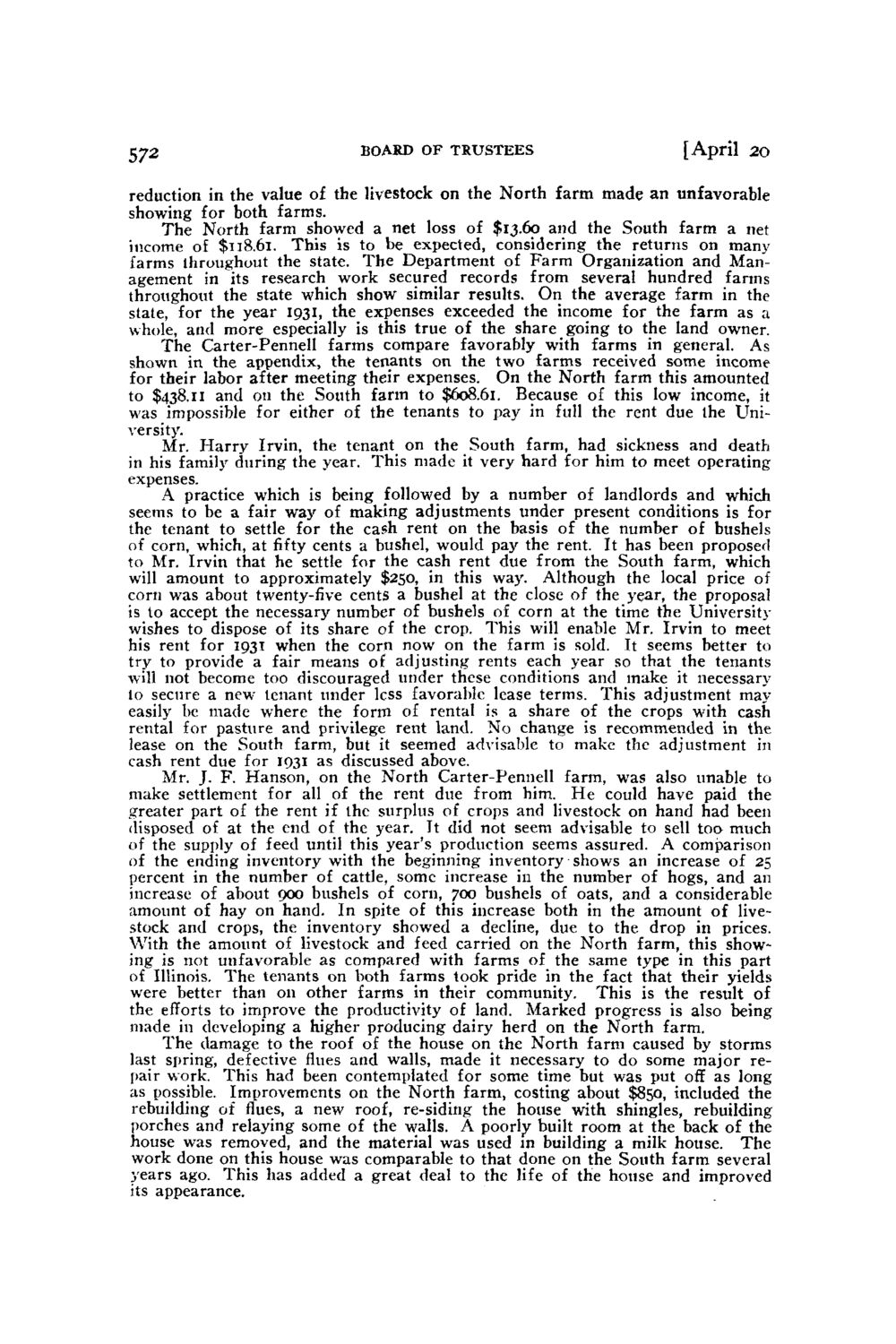| |
| |
Caption: Board of Trustees Minutes - 1932
This is a reduced-resolution page image for fast online browsing.

EXTRACTED TEXT FROM PAGE:
572 BOARD OF TRUSTEES [April 2 0 reduction in the value of the livestock on the North farm made an unfavorable showing for both farms. The North farm showed a net loss of $13.60 and the South farm a net income of $118.61. This is to be expected, considering the returns on many farms throughout the state. The Department of Farm Organization and M a n agement in its research work secured records from several hundred farms throughout the state which show similar results. O n the average farm in the state, for the year 1931, the expenses exceeded the income for the farm as a whole, and more especially is this true of the share going to the land owner. The Carter-Pennell farms compare favorably with farms in general. As shown in the appendix, the tenants on the two farms received some income for their labor after meeting their expenses. O n the North farm this amounted to $438.11 and on the South farm to $608.61. Because of this low income, it was impossible for either of the tenants to pay in full the rent due the University. Mr. Harry Irvin, the tenant on the South farm, had sickness and death in his family during the year. This made it very hard for him to meet operating expenses. A practice which is being followed by a number of landlords and which seems to be a fair way of making adjustments under present conditions is for the tenant to settle for the cash rent on the basis of the number of bushels of corn, which, at fifty cents a bushel, would pay the rent. It has been proposed to Mr. Irvin that he settle for the cash rent due from the South farm, which will amount to approximately $250, in this way. Although the local price of corn was about twenty-five cents a bushel at the close of the year, the proposal is to accept the necessary number of bushels of corn at the time the University wishes to dispose of its share of the crop. This will enable Mr. Irvin to meet his rent for 1931 when the corn n o w on the farm is sold. It seems better to try to provide a fair means of adjusting rents each year so that the tenants will not become too discouraged under these conditions and make it necessary lo secure a new tenant under less favorable lease terms. This adjustment may easily be made where the form of rental is a share of the crops with cash rental for pasture and privilege rent land. N o change is recommended in the lease on the South farm, but it seemed advisable to make the adjustment in cash rent due for 1931 as discussed above. Mr. J. F. Hanson, on the North Carter-Pennell farm, was also unable to make settlement for all of the rent due from him. H e could have paid the greater part of the rent if the surplus of crops and livestock on hand had been disposed of at the end of the year. It did not seem advisable to sell too much of the supply of feed until this year's production seems assured. A comparison of the ending inventory with the beginning inventory shows an increase of 25 percent in the number of cattle, some increase in the number of hogs, and an increase of about 900 bushels of corn, 700 bushels of oats, and a considerable amount of hay on hand. In spite of this increase both in the amount of livestock and crops, the inventory showed a decline, due to the drop in prices. With the amount of livestock and feed carried on the North farm, this showing is not unfavorable as compared with farms of the same type in this part of Illinois. The tenants on both farms took pride in the fact that their yields were better than on other farms in their community. This is the result of the efforts to improve the productivity of land. Marked progress is also being made in developing a higher producing dairy herd on the North farm. The damage to the roof of the house on the North farm caused by storms last spring, defective flues and walls, made it necessary to do some major repair work. This had been contemplated for some time but was put off as long as possible. Improvements on the North farm, costing about $850, included the its appearance.this house wasa material was poorly builtwith a at and rebuilding house done ofrelayingaadded ofcomparable to used house onthe housethehouse.ofThe years ago. removed, some roof, re-siding the doneof roomSouth farm porches andon flues, and the great deal A that lifebuilding shingles,backseveral work was rebuilding This has new the walls. the in the milk improved the
| |